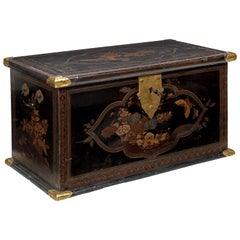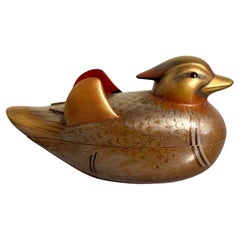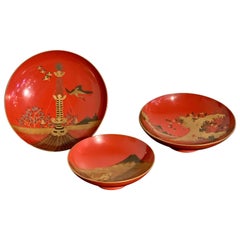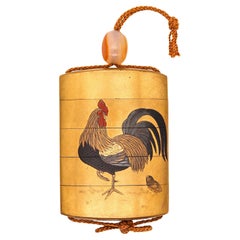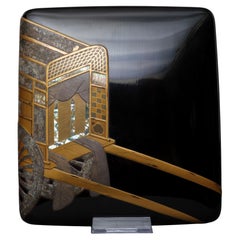Japanese Lacquer
to
20
157
91
287
1
1
2
1
53
142
92
2
55
14
6
6
1
6
2
1
2
3
227
141
86
39
23
556
489
289
194
42
289
288
288
1
1
1
1
1
Place of Origin: Japanese
Large Royal Early 17th Century Japanese Lacquer Chest with Gilt-Bronze Mounts
Located in Amsterdam, NL
A large Japanese transitional lacquer chest with gilt-metal mounts
Edo period, early 17th century
The rectangular chest with flat hinged lid decorated in gold, silver, and red ...
Category
Early 17th Century Antique Japanese Lacquer
Materials
Bronze
Vintage Japanese Lacquer Duck Box by Zohiko, Showa Era, Mid 20th Century, Japan
By Zōhiko Studio
Located in Austin, TX
A finely decorated vintage Japanese box for precious incense, kogo, in the shape of a male mandarin duck, oshidori, by Zohiko, Showa Era, 1960's, or earlier.
The lovely and whimsic...
Category
1960s Showa Vintage Japanese Lacquer
Materials
Wood, Lacquer
Japanese Lacquer Sake Cups, Set of 3, Meiji Period, Early 20th Century, Japan
Located in Austin, TX
A finely decorated set of 3 red lacquer sake cups, sakazuki, featuring views of Mt. Fuji, Meiji period, circa 1900, Japan.
The lacquer sake cups, called sakazuki, of traditional p...
Category
Early 1900s Meiji Antique Japanese Lacquer
Materials
Lacquer
Japan 1810 Kajikawa Edo Period Five Drawer Inro Lacquered Gilt Wood With Rooster
Located in Miami, FL
Japanese Inro from the Edo period (1615-1868) created by Kajikawa.
Beautiful Inro, created in Japan by one of the Kajikawa family during the Edo period (1615-1868), circa 1810. Has been carefully crafted in carved precious wood with applications of gilding maki-e and decorated with Japonism patterns. All dan trays are attached together with a himo cord. The detailed craftsmanship was a true pleasure to behold.
Period: Edo period (1615-1868). Shogunate.
Approximate Date: 1790-1810
Motif: A family of birds consisting of a cockerel, the hen and three chicks.
Drawers: Five.
Shape: Rectangular navette.
Technique: Carved wood, lacquer and decorated in iroe-hiramaki-e on a gold ground.
Ojime: 15mm 20mm, oval carved from natural translucent agate.
Netsuke: None
Weight: 47.70 Grams.
Measurements: Inro is 78 mm by 55 mm by 18 mm (3.07 x 2.17 x 0.71 Inches).
Signatures: Kajikawa Saku, in the underside with the signature KAJIKAWA. By a member of the Kajikawa family, signed Kajikawa 梶川 Japan, late 18th century to early 19th century, Edo period (1615-1868).
The Kajikawa family
Kajikawa family, flourished in the 19th century, they was Japanese lacquerware artists whose school in Edo (now Tokyo) flourished for more than 200 years. This family is perhaps the most famous of all the dynasties of Japanese lacquer artists, and certainly the name most often found on inro. The family is said to have been founded by Hikobei at Edo in the early 17th century, although some claim that the family’s great reputation really stemmed from his son and pupil Kyujiro. In any event, Hikobei worked for the shogunate, as did his successors until well into the 19th century. Kijirō excelled in designing particularly delicate lacquer inrō, portable medicine cases...
Category
1810s Edo Antique Japanese Lacquer
Materials
Agate, Gold
$3,115 Sale Price
30% Off
Japanese Lacquer and Cinnabar "Samurai" Cabinet, Inaba Family, Edo Period
Located in Troy, NY
Exceptionally large and rare lacquer cabinet. According to the heraldry, visible on the headgear in one of the panels, it was made for the Inaba family, a high ranking Daimyo family,...
Category
Late 19th Century Edo Antique Japanese Lacquer
Materials
Wood
Japanese lacquer suzuri’bako 硯箱 (writing box) with ‘Rinpa School’-style design
Located in Amsterdam, NL
Superb rectangular ‘Rinpa School’-style black lacquer suzuri’bako (writing box) with a slightly arched well-fitted overhanging cover with rounded corners.
The lid with a design of a gosho’guruma (ox-drawn carriage for Heian-era nobles) featuring golden hiramaki-e (low-relief lacquer design) and takamaki-e (high-relief lacquer design), inlays of lead and shiny mother-of-pearl (raden). The design continues along the sides.
The reverse of the lid decorated with two large curving pine trees (matsu) executed in the same way, but also with intricate dots of tiny pieces of inlaid blue mother-of-pearl along the golden trunk.
The interior shaped to hold various scholar’s accessories, including a partially gold lacquered inkstone (suzuri) and a bronze waterdropper (suiteki) shaped like a mythical minogame.
The interior inscribed ‘Hokkyô Kôrin zô’ (Made by Hokkyô Kôrin). Referring to the design being in style of the master Ogata Kôrin, but the actual lacquer artist is unknown. It is a homage to Kôrin by an artist that followed the school of Rinpa.
Including black lacquer wooden tomobako (tomobako).
The Rinpa School was a key part of the Edo period revival of indigenous Japanese artistic interests described by the term yamato-e. Paintings, textiles, ceramics, and lacquerwares were decorated by Rinpa artists with vibrant colours applied in a highly decorative and patterned manner. Favoured themes, which often contained evocative references to nature and the seasons, were drawn from Japanese literature, notably The Tale of Genji, The Tales of Ise...
Category
19th Century Antique Japanese Lacquer
Materials
Brass, Lead
Japanese Negoro Style Lacquered Worship Stand, 17th-18th Century
Located in Fukuoka, JP
"Discover a piece of Japanese religious heritage with this exceptional Negoro lacquered stand. Crafted in the 17th to 18th century, this worship article stand is a prime example of e...
Category
Late 17th Century Edo Antique Japanese Lacquer
Materials
Wood, Lacquer
Japanese Lacquer Trays
Located in Pasadena, CA
This is a wonderful collection of 6 mid-20th century Japanese Lacquer Trays. There is one pair of oxblood red with highlights; one pair of matched oil spot trays and one near pair of oil spot lacquer trays. All of the trays are in good overall condition with minor anticipated chips and patina to the edges. One of the cinnabar...
Category
Mid-20th Century Japanese Lacquer
Materials
Wood, Lacquer
$975 / set
Japanese tea house in rankanku or eggshell lacquer with a decor of gold crane
Located in PARIS, FR
Miniature tea house with a crane and bamboo motif in black and gold takamaki-e lacquer on a rankaku (eggshell inlay) base. It has several compartments and trays on the roof, walls an...
Category
Late 19th Century Meiji Antique Japanese Lacquer
Materials
Gold
Superb Late 16th Century Signed Colonial Japanese Namban Export Lacquer Coffer
Located in Amsterdam, NL
Superb late 16th century signed colonial Japanese Namban export lacquer coffer
Momoyama period, late 16th/early 17th century, inscribed 'Arisato' on the bottom
H. 30.5 x W. 43...
Category
16th Century Antique Japanese Lacquer
Materials
Cedar, Lacquer
Japanese Lacquer Incense Accessories Box, Kobako, Edo Period, mid 19th c, Japan
Located in Austin, TX
A remarkable Japanese maki-e lacquer box for incense accessories, kobako, with interior fitted tray, kakego, designed with a temple complex scene, late Edo Period, mid 19th century, ...
Category
Mid-19th Century Edo Antique Japanese Lacquer
Materials
Silk, Softwood, Cypress, Lacquer
Large Japanese Namban Lacquer Coffer Arqueta, 16th Century
Located in Amsterdam, NL
A large Japanese Namban lacquer arqueta coffer for the Portuguese market
Kyoto, Momoyama-period, late 16th century
In Hinoki cypress lacquered in ...
Category
16th Century Antique Japanese Lacquer
Materials
Mother-of-Pearl, Wood
Japanese Lacquer Suzuribako 硯箱 'Writing Box' by Hattori Toshio 服部俊夫 '1943'
By Hattori Toshio (Shunsho)
Located in Amsterdam, NL
A small Japanese black and gold lacquer suzuribako (writing box) with cartwheels in water, by the artist Hattori Toshio (1943).
Of rectangular form with rounded corners, bearing a lustrous rôiro ground throughout, the exterior sides of the box and exterior of the cover finely decorated in gold and little silver takamaki-e with cartwheels flowing in a dynamically executed body of water with many swirls
and gushes as well as scattered dew drops, the interior tray fitted with a rectangular ink stone and silver suiteki (waterdropper).
The underside signed ‘Toshi’.
With the original wooden tomobako with hakogaki reading Namikuruma makie suzuribako (The
writing box set, with a design of wheels in water), as well as a leaflet written in Japanese with the artist’s biography up to 1987.
Hattori Toshio (b. 1943), art name Hattori Shunsho, was first selected for the Nitten exhibition in Showa 38 (1963). Since then, he has exhibited more than twenty times at the Nitten and other exhibitions, winning numerous prestigious awards. In 1995,
he had an audience with Pope John Paul II and presented the Pope with a lacquer reading table. In 2004, he created the shelves for the guest room of the Kyoto State Guest House of the Government of Japan. He is a member of the Kyoto Crafts Artists Association, the Kyoto Lacquer...
Category
Late 20th Century Japanese Lacquer
Materials
Wood, Giltwood, Lacquer
Lacquer Craftsman's Work Drawer / Antique Work Table / Wabi-Sabi Art
Located in Sammu-shi, Chiba
We have a unique Japanese aesthetic sense.
And only we can introduce unique items through our purchasing channels in Japan and the experience we have gained so far, in such a way tha...
Category
Early 20th Century Taisho Japanese Lacquer
Materials
Cedar
Japanese Lacquer Box, Kogo, Tale of Genji, Edo Period, early 19th century, Japan
Located in Austin, TX
A fine Japanese small lacquer box for precious incense, kogo, Edo period, mid 19th century, Japan.
The small box of gold lacquer and wonderfully dec...
Category
Early 19th Century Edo Antique Japanese Lacquer
Materials
Pewter
Beautiful Japanese Lacquered Tray Raden Abalone Shell Decoration
Located in Fukuoka, JP
Beautiful Japanese Lacquered Tray with Raden Abalone Shell Decoration
This beautiful Japanese lacquered tray is a stunning example of Japanese craftsmanship. It is made of high-quality wood and is decorated with abalone shell inlay, a technique known as raden. Raden is a centuries-old Japanese art form that involves inlaying mother-of-pearl, abalone shell, or other materials into a lacquer surface. The technique originated in China and was introduced to Japan in the Nara period...
Category
20th Century Japanese Lacquer
Materials
Lacquer
Japanese Black Lacquer Document Box with Gold Plum Blossom Design, Taisho Period
Located in Prahran, Victoria
A high quality, antique, Japanese black lacquer document box. It has an external design of gold maki e plum blossoms. In Japanese culture plum blossom symbolises the beginning of Spring, having its own festival, the Ume Matsuri, alongside the more famous cherry blossom festival...
Category
1920s Vintage Japanese Lacquer
Materials
Wood, Lacquer
$2,880 Sale Price
20% Off
Antique Japanese Lacquered Incense Box Kobako Ex-Christie's
Located in Atlanta, GA
An old Japanese lacquered small box likely used to contain incense powder called Kobako, circa Momoyama to early Edo period (16-17th century). The rectangular form box with a fitted ...
Category
17th Century Japonisme Antique Japanese Lacquer
Materials
Lead
Asian Japanese Red Lacquered Footed Bowl Centerpiece
Located in Moreno Valley, CA
Large vintage Japanese shallow footed bowl in red lacquer with gold calligraphy design.
This beautiful lacquerware were made to serve foods during elaborate banquet.
Great decorative...
Category
Mid-20th Century Japonisme Japanese Lacquer
Materials
Lacquer, Paint
Japanese Lacquer Incense Box, Kogo, Momoyama or Edo Period, 16th/17th Century
Located in Austin, TX
A wonderful Japanese lacquer incense box, kogo, with a design of plovers in flight, late Momoyama or early Edo Period, circa 1600, Japan.
The small box, called a kogo, was used to s...
Category
Early 17th Century Edo Antique Japanese Lacquer
Materials
Gold, Pewter
Japanese 7-Pcs, Arita Sweetmeat Set & Matching Lacquer Box Meiji Period, 1880s
Located in Ottawa, Ontario
A seven-piece Japanese Arita Sweetmeat set and matching lacquer box, Meiji period (1880-1890). Comprising of a central hexagonal dish and six-fan shaped ...
Category
Late 19th Century Meiji Antique Japanese Lacquer
Materials
Porcelain, Lacquer
Japanese Maki-e Lacquer Stack Box Jubako
Located in Atlanta, GA
An antique jubako (stack boxes) with five tiers in an elongated octagon shape circa 19th century (end of Edo or beginning of Meiji period). jubako was traditionally used to store and...
Category
19th Century Japonisme Antique Japanese Lacquer
Materials
Wood, Lacquer
Japanese Edo Period Igarashi School Long Lacquer Box, Tanzaku-Bako
Located in Austin, TX
A stunning Japanese Edo period lacquer tanzakubako, box for poem cards, late 18th-early 19th century, Edo Period, Japan.
Attributed to the Igarashi School, this box is masterfully ...
Category
Early 19th Century Edo Antique Japanese Lacquer
Materials
Mother-of-Pearl, Lacquer
An exceptional Namban 'escritório' writing-box, with a single drawer
Located in Amsterdam, NL
Kyoto, Late Momoyama to Edo period, circa 1590-1630
Decorated in pearl shell and gold with branches, leaves and flowers inside cartouches on a pearl shell mosaic background.
H. 25 ...
Category
17th Century Antique Japanese Lacquer
Materials
Gold
Japanese Lacquered Tebako 'Box'
Located in PARIS, FR
Tebako box with three compartments in golden and nashi-ji lacquer, decorated with golden, red, and kirigane lacquer, golden persimmon tree leaves, among rocks. The compartments are of increasing size from the top. The decoration is in continuity.
Persimmon has been cultivated in southern China for more than 2500 years and is believed to have been introduced to Japan in the 8th century. The veneer is a tree with very hard wood, similar to ebony. According to a legend, one specimen survived the atomic bombing of Nagasaki on August 9, 1945, close to the epicenter. It is therefore in Japan a symbol of strength and longevity. It is also the national fruit of the country. It is eaten as a traditional dish during New Year's Day celebrations.
Tebako literally means "portable box...
Category
1860s Antique Japanese Lacquer
Materials
Lacquer
Mother-of-Pearl Black Lacquer Japanese Export Table with Feet Shaped as Bats
Located in Amsterdam, NL
A Japanese export lacquer tripod table with feet shaped as bats
Nagasaki, 1850-1860
H. 73 x diam. 108 cm
The six-lobbed top is decorated with reverse-painted mother-of-pearl in a sprawling motif of plum blossom, bamboo, and peonies, surrounded by fluttering sparrows enhanced by details in maki-e.
The table, made to appeal to a foreign audience, incorporates a curious mixture of seasonal references. In addition to the decoration of foliage from late winter and spring, the column is decorated with grapes and a rabbit pounding rice, both Japanese motifs for autumn and the month of September. The feet, shaped like bats that almost appear to wake up from hibernation, symbolise luck and happiness in Japan.
The present flamboyant Nagasaki-style table is depicted in the Asada workshop drawings of 1856. These drawings, titled Aogai makie hiinagata hikae (memorandum of designs for lacquer with inlaid pearl...
Category
19th Century Antique Japanese Lacquer
Materials
Lacquer
Japonese Lacquered Box with Flower, Late of the 19th Century
Located in Beuzevillette, FR
Nice little black lacquer box from Japan. It is made of black lacquered wood and decorated with flowers and foliage. The inside is covered with red velvet. It is ideal for storing je...
Category
Late 19th Century Antique Japanese Lacquer
Materials
Lacquer
Antique Japanese Inro by Shigehide Edo Period
Located in Atlanta, GA
This exquisite four-case lacquered inro was dated to the latter part of 18th century to early 19th century (Edo period) and made by Shigehide. The opposite sides of the inro together features a lavish flower arrangement in a bamboo basket (ikebana). The detailed craftmanship was a true pleasure to behold. Mostly Takamaki-e (high relief) were used to texturize the delicate petals of the chrysanthemums, on which different shades of gold were used to create contrast. Raden (mother of pearl) shells were also used to highlight some leaves, rendering the piece an interesting balance of color and material. The interior was completed in a mottled gold finish. It was signed Shigehide on the bottom with a Kao. There is a small carved rabbit ojime bead...
Category
Late 18th Century Japonisme Antique Japanese Lacquer
Materials
Wood, Lacquer
Vintage Japanese Black, Gold and Red Lacquer Document Fubako Box
Located in Sheridan, CO
Black, Gold and Red Lacquer Japanese Document Fubako Box, Meiji period, late 19th C/Early 20th C. A Japanese lacquer box featuring hand decorated gold paint depicting scholars and sa...
Category
1920s Meiji Vintage Japanese Lacquer
Materials
Lacquer
Uniquely Shaped Lacquer Box with Tachibana Clan Crests – 19th Century
Located in Fukuoka, JP
An impressive and unusually shaped Japanese lacquered box, bearing the gold crests of the prestigious Tachibana samurai clan. This elegant piece dates to the late Edo to early Meiji ...
Category
19th Century Edo Antique Japanese Lacquer
Materials
Wood, Lacquer
Japanese Lacquer Maki-E Scroll Box Fubako by Kansonsai Edo Period
Located in Atlanta, GA
A Japanese lacquered wood fubako (a box to store document or small scroll painting) circa late 18th century of Edo period. The rectangular box features a deep lid with rounded corners and recessed mid-edge and a lower box with two bronze medallion rings and tasseled silk ties. The surface of the fubako was elaborately decorated with hiramaki-e and a low takamaki-e on a mottled Mura-nashiji background. The motifs on the lid depict branches of Japanese pine with finely rendered needles on the lower part; on the upper part, it showcases fruited persimmon branches. Two different shades of gold fundame were used to contrast the design and augmented by scattered gold kirigane to highlight some of the leaves. The design continues and cascades down to all sides of the lid as well as the walls of the box. The two bronze medallions appear original to the box and the silk ties show significant fading from the age. This Fine fubako is signed on the lower wall "Kanshosai" in Kanji with a kao mark. All the trims were finished in gold fundame and the interiors a dense nashiji in gold.
Kanshosai is the mark of the distinguished lacquer artist Lizuka Toyo I who also signed his work "Toyosai". He was active in the second half of the 18th century during Edo period, employed by Hachisuka Shigeyoshi (1738-1801), daimyo of Awa on Shikoku Island. Although most survived work bearing his marks are inros, he was also known to decorated trays and other larger objects...
Category
Late 18th Century Edo Antique Japanese Lacquer
Materials
Wood, Lacquer
Japanese Red & Black Lacquer Bowl, Early 20th Century
Located in Jimbaran, Bali
A Japanese red & black lacquer bowl from the early 20th century. Its frame is crafted from woven rattan fibres and covered in multiple layers of lac...
Category
Early 20th Century Other Japanese Lacquer
Materials
Rattan, Lacquer
Antique Japanese Lacquer and Inlay Box from Ryukyu Island
Located in Atlanta, GA
A lacquer presentation box with mother-of-pearl inlays from Japanese Ryukyu Islands circa 17-18th century. The lidded box in rectangular form with rounded corner is a classic example...
Category
18th Century Japonisme Antique Japanese Lacquer
Materials
Mother-of-Pearl, Lacquer
Antique Japanese Lacquer Stacking Food Box 'Jubako'
Located in Hudson, NY
With all-over mother of pearl inlay and mon design of chrysanthemum in gold and black lacquer on top. The chrysanthemum is a national symbol of Japan and the Imperial family.
Category
19th Century Antique Japanese Lacquer
Materials
Gold
Large Japanese Red & Black Lacquer Wooden Bowl, Early 20th Century
Located in Jimbaran, Bali
A Japanese red & black lacquer wooden bowl from the early 20th century. It is carved from a block of what is likely to be fruit wood. The bowl has aged beautifully over the years wit...
Category
Early 20th Century Meiji Japanese Lacquer
Materials
Fruitwood, Lacquer
Japanese Lacquer Tray with Maki-e and Inlay Hara Yoyusai Edo Period
Located in Atlanta, GA
A lovely Japanese lacquer rectangular lacquer tray with a slightly scalloped corner and four L shape supporting feet by one of the most celebrated lacquer artist active in Edo period Hara Yoyusai (1772-1845). Yoyusai lived in Edo (Tokyo) and worked under the patronage of Lord Matsudaira. He operated a large workshop and had a very prolific output of lacquer objects. Most survived pieces being inro...
Category
19th Century Japonisme Antique Japanese Lacquer
Materials
Wood, Lacquer
Japanese Lacquer Meiji Period Cabinet on Stand, circa 1890
Located in Brighton, Sussex
A exquisite, fine quality Meiji period (1868-1912) Japanese black lacquer cabinet on stand with wonderful scrolling gilded decoration. H...
Category
Late 19th Century Japonisme Antique Japanese Lacquer
Materials
Lacquer
Rare 17th Century Japanese Export Lacquer Medical Instrument Box
Located in Amsterdam, NL
A rare Japanese export lacquer medical instrument box
Edo-period, 1650-1700
L. 19 x W. 6 x H. 8.5 cm
This unconventionally shaped lacquer b...
Category
17th Century Edo Antique Japanese Lacquer
Materials
Gold
Japanese Lacquer Accessories Box, Tebako, Brocade Design, Meiji Period, Japan
Located in Austin, TX
A very fine Japanese lacquer tebako, box for personal accessories, in the form of rolled bolts of brocade fabric, Meiji Period, late 19th century, Japan.
The box is whimsically shap...
Category
Late 19th Century Meiji Antique Japanese Lacquer
Materials
Softwood, Lacquer
Fine Japanese Namban Lacquer Jewelry Casket, 17th Century
Located in Amsterdam, NL
Japanese Namban lacquer transition-style coffer with two drawers
Kyoto/Nagasaki, circa 1650
The cartouches with gilt and red decorations of leaves...
Category
17th Century Edo Antique Japanese Lacquer
Materials
Cypress
Japanese Tebako in Nashiji lacquer adorned with golden Persimon flowers
Located in PARIS, FR
Tebako box with two compartments in golden and nashi-ji lacquer, decorated with golden, red, and kirigane lacquer, golden persimmon tree leaves, among rocks. The compartments are of ...
Category
Early 19th Century Meiji Antique Japanese Lacquer
Materials
Gold
Antique Japanese Lacquer and Inlay Table from Ryukyu Islands
Located in Atlanta, GA
A small square-form table with lacquer and intricate mother-of-pearl inlay design from Ryukyu Islands kingdom circa 17-18th century. Ryukyuan kingdom was used to be an independent is...
Category
18th Century Edo Antique Japanese Lacquer
Materials
Mother-of-Pearl, Lacquer
Japan 1800 Edo Period Six Drawer Inro In Lacquered Gilt Wood With Utensils
Located in Miami, FL
Japanese Inro from the Edo Period (1603-1867).
Beautiful Inro, created in Japan during the Edo period (Shogunate), circa 1800. It was carefully crafted in carved precious wood with ...
Category
Early 1800s Edo Antique Japanese Lacquer
Materials
Coral
$2,275 Sale Price
30% Off
Japanese Namban Chest adorned with cylindrical motives and mother of pearl inlay
Located in PARIS, FR
Small namban style chest with a semi-cylindrical lid made of black lacquered wood (urushi) with gold lacquer (maki-e) and inlaid with mother-of-pearl (raden).
Mon style decoration (...
Category
Mid-18th Century Antique Japanese Lacquer
Materials
Lacquer, Mother-of-Pearl
Japanese Lacquer Ryoshibako Document Box Meiji Period
Located in Atlanta, GA
A large Japanese lacquer box with elaborate Maki-e design from Meiji period, (mid-late 19th century). The generous size of the box was reser...
Category
19th Century Japonisme Antique Japanese Lacquer
Materials
Wood, Lacquer
Japanese Red and Black Lacquer Maki-e Decorated Presentation Tray, dated 1917
Located in Austin, TX
A fine Japanese red and black maki-e lacquer presentation tray with original tomobako storage box, Taisho period, dated 1917, Japan.
The large prese...
Category
1910s Taisho Vintage Japanese Lacquer
Materials
Gold
Pair Japanese Lacquer Habachi
Located in Pasadena, CA
This is a beautiful example of the perfection of Japanese Minimalism design that dates to the Showa or possibly Taisho era. The simplicity of the circular form and minimal decoration...
Category
20th Century Showa Japanese Lacquer
Materials
Copper
$1,400 Sale Price / set
20% Off
Japanese Edo Period Black & Gold 'Nagamochi' Dowry Trunk with Family Crests
Located in London, GB
A Fine Black & Gold Lacquer
Japanese Nagamochi Trunk
With Family Crests of the Tokugawa and Minamoto Clans
Of rectangular form, the storage trunk covered on all sides with hiramak...
Category
19th Century Edo Antique Japanese Lacquer
Materials
Lacquer
Exquisite Japanese Lacquer Maki-e Hand Box Kobako Edo Period
Located in Atlanta, GA
An early Japanese lacquer Maki-e decorated kobako (small storage box) circa 18th century (Edo period). Based on its form and size, this kobako was possibly used as a Chabako to store the accoutrements for chado (tea ceremony). The lidded box is of rectangular form with bevel design on all edge that softens the appearance. The entire surface was densely covered with a background of nashiji. Elaborate Maki-e techniques were used on each side to showcase a distinct landscape or floral design within a cartouche panel. On the surface of the lid, a mountainous landscape rises from the edge of the water. The poetic composition is akin to a traditional ink scroll...
Category
18th Century Edo Antique Japanese Lacquer
Materials
Lacquer
Japanese Lacquer Hokai Box, 19th Century
Located in Pasadena, CA
This is a good example of a traditional Japanese Hokai shell storage box for the Kai-awase game. This box is well-detailed in chased brass appliques and makie. The box is in overall ...
Category
Late 19th Century Japonisme Antique Japanese Lacquer
Materials
Wood, Lacquer
$1,175 Sale Price
24% Off
Fine Japanese Lacquered Inro with Inlays by Kajikawa
Located in Atlanta, GA
A Japanese four-case lacquer inro by a member of Kajikawa family circa 19th century (late Edo to early Meiji period). It depicts a nocturnal scenery of a meandering stream surrounded by bush clovers, where a full moon is reflected on the water. It was masterfully decorated in gold and silver maki-e using a combination of techniques including takamakie, togidashi and kirigane as well as aogai (abalone shell) inlays. The stream was set between the slightly elevated banks, adding to this piece a already strong three-dimensional composition. The interior was decorated in gold nashiji. It was signed on the bottom "Kajikawa Zou" (made by Kajikawa and a pot seal centered with "Ei" in Kanji. In one of the compartment, there is a katakana mark, appears to be a name, possibly the owner.
Kajikawa clan was one of the most famous lacquer artisanal family established in the 17th century. Many well known members over the generations produced lacquer art in a wide range of formats, but two third were signed only with the family name such as this one. It is therefore not possible to pinpoint the exact author of this piece.
Provenance: This inro was purchased as lot 349 in Christie's New York sale Japanese...
Category
19th Century Japonisme Antique Japanese Lacquer
Materials
Shell, Wood, Lacquer
A Maki-e Lacquer Tebako Box Embellished With Gold Decorations
Located in Milano, IT
Scatola tebako in lacca maki-e impreziosita da decorazioni dorate che raffigurano un tempio buddista circondato da maestosi pini Matsu. L’interno e la base sono rifiniti in lacca nas...
Category
19th Century Antique Japanese Lacquer
Materials
Lacquer
Japanese Red Lacquer Negoro Hibachi with Rabbits, Edo Period, c. 1850
Located in Chicago, IL
With monumental scale and beautiful, hand-carved details, this remarkable red lacquer hibachi is a true work of art. Designed to hold glowing embers, hibachi vessels such as this were used for cooking or as a source of heat in Japanese homes. Placed under a low wood kotatsu table...
Category
Mid-19th Century Edo Antique Japanese Lacquer
Materials
Metal, Bronze, Copper
A rare Japanese Namban export lacquer coffer with Mon emblems
Located in Amsterdam, NL
Late Momoyama period, late 16th century
The coffer is decorated in black lacquer, urushi, on cedar wood, decorated with gold dust and silver, maki-e, and nashiji, mother-of-pearl, r...
Category
16th Century Antique Japanese Lacquer
Materials
Silver, Copper
Japanese Lacquered Furoshiki Kobako 'Box'
Located in PARIS, FR
Rectangular and flat lacquer Kobako (small box) representing a furoshiki knot seen from above. Fundame background, furoshiki in takamaki-e with floral pattern, inside the folds of the fabric with black and gold sayagata pattern with togidashi maki-e technique. The saya (or sayagata) pattern is composed of Chinese swastikas...
Category
Late 19th Century Antique Japanese Lacquer
Materials
Lacquer
Japanese inro box in black and gold lacquer with a decor of snowy landscape
Located in PARIS, FR
Inrō with four boxes in black and gold lacquer, representing a person in a pavilion in a snowy landscape with mountain on the background. Realised in maki-e on black lacquer with sma...
Category
Late 18th Century Edo Antique Japanese Lacquer
Materials
Gold
Inro in black and gold lacquer with a proeminent chrysantemum flower motive
Located in PARIS, FR
Two compartments inrô in black lacquer, hira maki-e and mother-of-pearl inlay on a hirameiji background, decorated with a bouquet of chrysanthemums in a small purse, a hoe on the other side, and a fluttering butterfly which can be found on both sides. The interior is in hirameiji lacquer. The ojime is a drum made out of black lacquer and ivory with a mother-of-pearl inlay. The Manjû netsuke...
Category
Mid-18th Century Edo Antique Japanese Lacquer
Materials
Gold
Japanese Namban Lacquer and Inlay Coffer Momoyama Period
Located in Atlanta, GA
A rare Japanese Namban Lacquer domed coffer circa 1570-1610s of Azuchi-Momoyama to early Edo period. These types of lacquerware were made for export to ...
Category
16th Century Japonisme Antique Japanese Lacquer
Materials
Wood, Lacquer
Japanese Black and Gold Lacquer Kaioke Boxes 'Hokaibako'
Located in PARIS, FR
Two big eight-sided kaioke boxes in black lacquer, decorated with mon and maple leaves in golden lacquer.
These are usually octagonal boxes containing the painted shells used in ...
Category
Late 19th Century Antique Japanese Lacquer
Materials
Lacquer
Japan lake landscape kobako box lacquer - Edo
Located in PARIS, FR
Rectangular kobako box in takamaki-e and kirigane gold lacquer circled with pewter depicting a lake landscape. Inside and back of the box in nashi-ji lacquer.
Japan – Edo period (16...
Category
18th Century Antique Japanese Lacquer
Materials
Gold
Recently Viewed
View AllMore Ways To Browse
Chinese Carved Cinnabar Red Lacquer
Korean Mother Of Pearl Furniture
Antique Chinese Fan
Japanese Containers
Chinese Lacquer Plate
Lacquered Japanese Bowl
Negoro Lacquer
Gold Lacquer Tray
Chinese Lacquerware
Korean Mother Of Pearl
Copper Hibachi
Lacquer Hibachi
Chinese Lacquer Fan
Chinese Lacquer Board
Namban Lacquer
Burmese Lacquer Trays
Japanese Laquered
Japanese Negoro Lacquer
